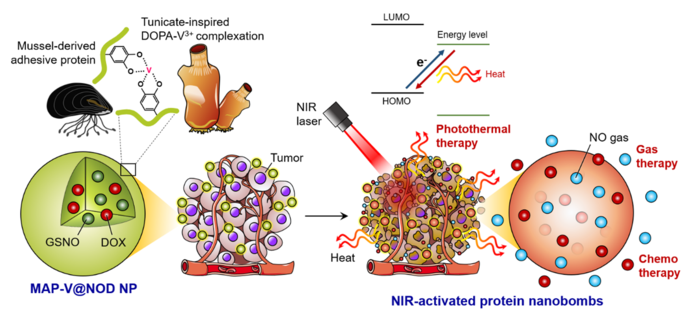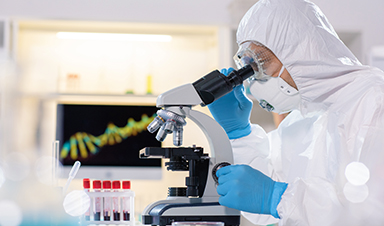Bioinspired by tunicates and mussels, a Korean research team has created a “bomb-like” anticancer therapeutic agent that only destroys cancer cells.

The nanobomb produces heat in precise sites where near-IR (NIR) laser is irradiated to create nitric oxide gas, which has an anticancer effect and concurrently discharges anticancer drugs to accomplish the trimodal treatment of photothermal-gas-chemo-therapy.
The POSTECH research team was headed by Professor Hyung Joon Cha and Dr. Yeonsu Jeong (Department of Chemical Engineering) in partnership with Professor Yun Kee Jo’s team at Kyungpook National University (Department of Biomedical Convergence Science and Technology, School of Convergence).
The researchers engineered a photoactivatable adhesive nanobomb with mussel adhesive proteins (MAPs) and the catechol-vanadium complex of tunicates that involves light-associated energy conversion through electron transfer. The term ‘photoactivatable’ denotes the characteristic where properties vary based on the external light.
Since cancer manifests via multiple biological pathways, a process that integrates several treatments rather than one single treatment is generally employed. But it is challenging to deliver several therapeutic agents at once to a particular cancer site because of the large amount of fluid found in the human body.
Among such approaches, light-triggered photothermal therapy (PTT) employs nanoparticles of metals, synthetic polymers or carbon. However, their weak biodegradability, which can cause a hazard of systemic toxicity, and low photothermal conversion efficiency — the efficiency at which the captured light is turned to heat — render effective cancer treatment tough.
To this, the researchers developed nanoparticles by incorporating the catechol-vanadium complexes — which help electrons and light travel in tunicates — to the MAP. When these nanoparticles are exposed to the light from NIR lasers, the temperature can be increased to 50 degrees within 5 minutes, displaying exceptional photothermal conversion efficiency of around 50%.
These nanoparticles can be retained on cancer cells for an extended period owing to the robust adhesiveness of MAP. Furthermore, the excellent biocompatibility and biodegradability of proteinic nanoparticles resolve the safety matter of traditional light-responsive nanotherapeutics.
When the nanoparticles comprising a thermo-sensitive nitric oxide (NO) donor and an anticancer drug were irradiated using the near-IR (NIR) laser, NO gas and drugs were effectively discharged due to the photothermal effect, verifying their likelihood for use in a nanobomb.
It is generally tough to retain the anticancer effects of NO gas as it rapidly biometabolizes. However, the nanobomb can regulate the release of gas with light, which significantly raises the delivery efficiency of NO.
In preclinical testing in animal models, the tumor grew back 15 days after being treated with only a single photothemal treatment, whereas the therapeutic effectiveness was extended with trimodal treatments using nanobombs as no tumors were seen for around 1 month.
With a single nanoparticle, various site-specific therapeutic agents can be locally administered and multimodal treatments can be easily controlled with a single stimulus, which will be effective in treating cancer patients in the future.
Professor Hyung Joon Cha, Department of Chemical Engineering, Pohang University of Science and Technology
“This nanobomb can be applied not only to photothermal-gas-chemo-therapy, but also to the delivery of therapeutics including genes and antibodies or contrast agents, and therefore can be widely used according to the specific needs of the patient or the condition,” Professor Hyung Joon Cha added.
This research was chosen as the front cover paper of the December issue of Advanced Healthcare Materials, a well-known journal in the domain of materials science.
The research was performed with the support from the National Research Foundation grant funded by the Ministry of Science and ICT of Korea, the National Research Foundation grant funded by the Ministry of Education of Korea, and the Marine BioMaterials Research Center grant funded by the Ministry of Oceans and Fisheries of Korea.
The mussel adhesive protein technology has gone through a technology transfer to Nature Glutech Co., Ltd., and clinical trials will take place after procuring investigational new drug (IND) approvals.
News
New Once-a-Week Shot Promises Life-Changing Relief for Parkinson’s Patients
A once-a-week shot from Australian scientists could spare people with Parkinson’s the grind of taking pills several times a day. The tiny, biodegradable gel sits under the skin and releases steady doses of two [...]
Weekly injectable drug offers hope for Parkinson’s patients
A new weekly injectable drug could transform the lives of more than eight million people living with Parkinson's disease, potentially replacing the need for multiple daily tablets. Scientists from the University of South Australia [...]
Most Plastic in the Ocean Is Invisible—And Deadly
Nanoplastics—particles smaller than a human hair—can pass through cell walls and enter the food web. New research suggest 27 million metric tons of nanoplastics are spread across just the top layer of the North [...]
Repurposed drugs could calm the immune system’s response to nanomedicine
An international study led by researchers at the University of Colorado Anschutz Medical Campus has identified a promising strategy to enhance the safety of nanomedicines, advanced therapies often used in cancer and vaccine treatments, [...]
Nano-Enhanced Hydrogel Strategies for Cartilage Repair
A recent article in Engineering describes the development of a protein-based nanocomposite hydrogel designed to deliver two therapeutic agents—dexamethasone (Dex) and kartogenin (KGN)—to support cartilage repair. The hydrogel is engineered to modulate immune responses and promote [...]
New Cancer Drug Blocks Tumors Without Debilitating Side Effects
A new drug targets RAS-PI3Kα pathways without harmful side effects. It was developed using high-performance computing and AI. A new cancer drug candidate, developed through a collaboration between Lawrence Livermore National Laboratory (LLNL), BridgeBio Oncology [...]
Scientists Are Pretty Close to Replicating the First Thing That Ever Lived
For 400 million years, a leading hypothesis claims, Earth was an “RNA World,” meaning that life must’ve first replicated from RNA before the arrival of proteins and DNA. Unfortunately, scientists have failed to find [...]
Why ‘Peniaphobia’ Is Exploding Among Young People (And Why We Should Be Concerned)
An insidious illness is taking hold among a growing proportion of young people. Little known to the general public, peniaphobia—the fear of becoming poor—is gaining ground among teens and young adults. Discover the causes [...]
Team finds flawed data in recent study relevant to coronavirus antiviral development
The COVID pandemic illustrated how urgently we need antiviral medications capable of treating coronavirus infections. To aid this effort, researchers quickly homed in on part of SARS-CoV-2's molecular structure known as the NiRAN domain—an [...]
Drug-Coated Neural Implants Reduce Immune Rejection
Summary: A new study shows that coating neural prosthetic implants with the anti-inflammatory drug dexamethasone helps reduce the body’s immune response and scar tissue formation. This strategy enhances the long-term performance and stability of electrodes [...]
Scientists discover cancer-fighting bacteria that ‘soak up’ forever chemicals in the body
A family of healthy bacteria may help 'soak up' toxic forever chemicals in the body, warding off their cancerous effects. Forever chemicals, also known as PFAS (per- and polyfluoroalkyl substances), are toxic chemicals that [...]
Johns Hopkins Researchers Uncover a New Way To Kill Cancer Cells
A new study reveals that blocking ribosomal RNA production rewires cancer cell behavior and could help treat genetically unstable tumors. Researchers at the Johns Hopkins Kimmel Cancer Center and the Department of Radiation Oncology and Molecular [...]
AI matches doctors in mapping lung tumors for radiation therapy
In radiation therapy, precision can save lives. Oncologists must carefully map the size and location of a tumor before delivering high-dose radiation to destroy cancer cells while sparing healthy tissue. But this process, called [...]
Scientists Finally “See” Key Protein That Controls Inflammation
Researchers used advanced microscopy to uncover important protein structures. For the first time, two important protein structures in the human body are being visualized, thanks in part to cutting-edge technology at the University of [...]
AI tool detects 9 types of dementia from a single brain scan
Mayo Clinic researchers have developed a new artificial intelligence (AI) tool that helps clinicians identify brain activity patterns linked to nine types of dementia, including Alzheimer's disease, using a single, widely available scan—a transformative [...]
Is plastic packaging putting more than just food on your plate?
New research reveals that common food packaging and utensils can shed microscopic plastics into our food, prompting urgent calls for stricter testing and updated regulations to protect public health. Beyond microplastics: The analysis intentionally [...]





















